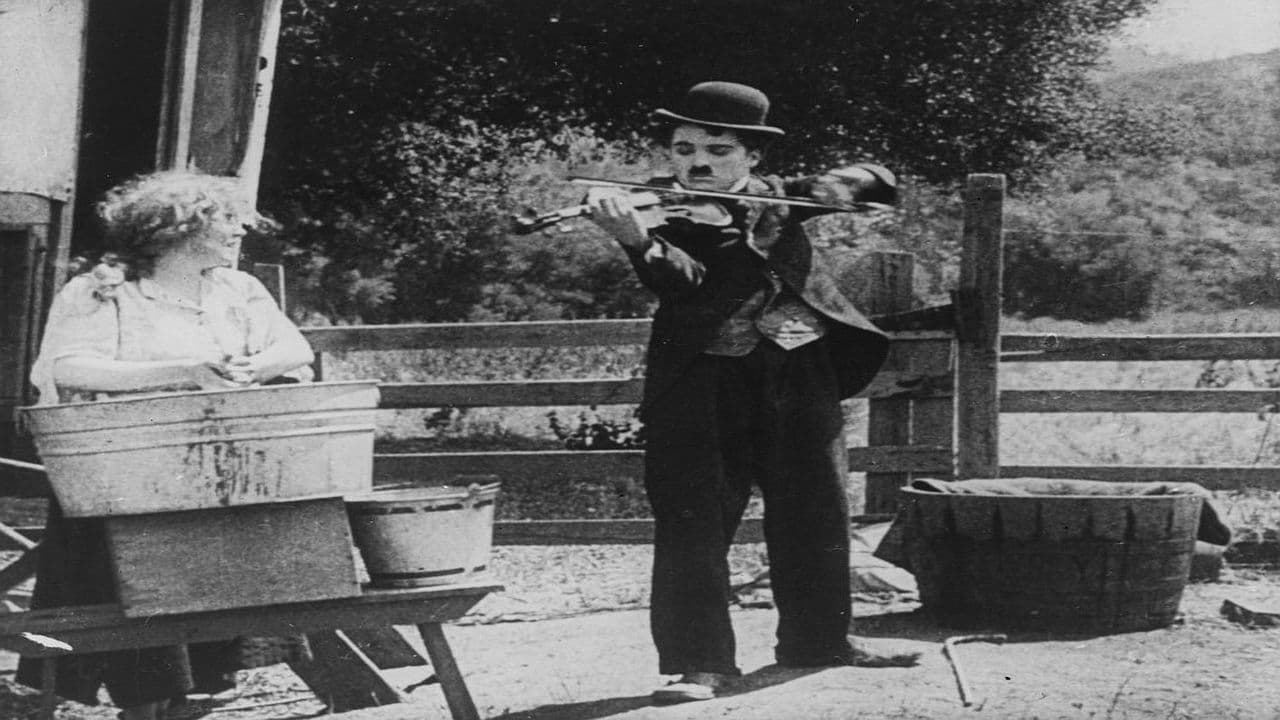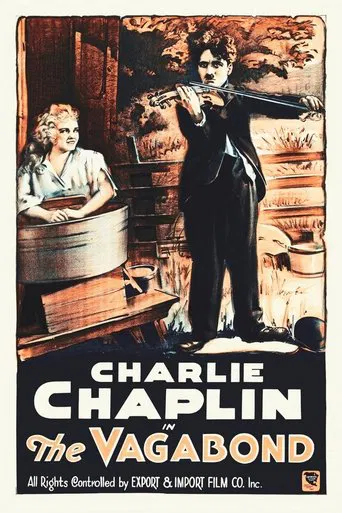

everything you have heard about this movie is true.
... View MoreClever and entertaining enough to recommend even to members of the 1%
... View MoreIt's a good bad... and worth a popcorn matinée. While it's easy to lament what could have been...
... View MoreIt is interesting even when nothing much happens, which is for most of its 3-hour running time. Read full review
... View MoreTHE VAGABOND (Mutual Studios, 1916), directed by Charlie Chaplin, stars the legendary Charlie Chaplin in his third comedy short for the studio. With Chaplin's attempt with improving himself with each passing film, rather than the usual twenty minutes of slapstick and chases, he deftly blends humor and sentiment, a standard that would later become associated by his technique in storytelling. Rather than playing a trouble-making tramp, this time Charlie's a violin playing drifter with more human qualities than before.The story opens in great comedy tradition as Charlie enters a bar to play his violin for the patrons. His music is drowned out by a German street band playing outside. As the band leader enters to collect money, he finds Charlie collecting the money instead. A brawl and chase ensues until the crowd loses themselves in the confusion, giving Charlie a chance to sneak away. Charlie next approaches a gypsy drudge where he plays for a gypsy girl (Edna Purviance) washing clothes. A brief cutaway of the plot shows a society matron (Charlotte Mineau), looking at an old photo of a little girl who, believed by its movie audience to have been abducted by gypsies many years ago. Now a young woman, the girl is shown to be an abused slave to the gypsy leader (Eric Campbell). Witnessing one of her brutal whippings that leaves her senseless, Charlie steps in to rescue her, leading to a wild escape down the road in a gypsy caravan. Resting in a secluded spot on a country road, Charlie, having assisted the gypsy girl with her every needs, finds himself in stiff competition when a struggling artist (Lloyd Bacon) enters the scene, inspired by the girl's beauty and uses her as a subject matter to his latest canvas painting, "The Living Shamrock." THE VAGABOND may not be one of Chaplin's most memorable of his comedy shorts for the Mutual Studios, but it represents him here more as a comic-actor rather than a just a slapstick one. Though scripted by Chaplin himself, the story seems to have some influence to Michael Balfe opera, "The Bohemian Girl," which also involves gypsies. While THE VAGABOND could very well have become a straight dramatic story for the possible choices of a Lillian Gish and Robert Harron under D.W. Griffith's direction, instead, it's Chaplin being both Griffith and Harron, and Purviance being Gish. Because its a two-reel comedy, it leaves very little detail for plot and character development. There are moments found in the film where it looks heavily edited. Usually when comedians do drama, or mix comedy with drama, the attempt fails. Fortunately for Chaplin, his method is believable and acceptable as long as he doesn't stray too far from his usual standard of comedy. Of the Chaplin stock players, including Leo White and Frank J. Coleman, Eric Campbell, later known as "Chaplin's Goliath," stands out as the hefty villainous gypsy with the whip, while the funniest performance comes from a character playing an old white-haired gypsy hag. No screen credit is given for his or her work. If played by an actor in drag, all the funnier. And the young artist, played by Lloyd Bacon, the same Bacon who would become a notable movie director himself.Presented on commercial television in the sixties as part of "Charlie Chaplin Theater," and unseen on public broadcasting television since the 1970s, THE VAGABOND was later resurrected a decade later on cable channels and home video. Though various editions have different underscoring, ranging from orchestration to jazz rhythm and blues, Blackhawk Video's edition consisted of reissue prints presented in theaters of the 1930s with the use of sound effects and instrumental scoring to "The Vagabond Lover" and theme scoring used for the independent feature, VANITY FAIR (Allied Pictures, 1932) starring Myrna Loy. When shown on Turner Classic Movies (TCM premiere: December 6, 1999) as part of its "star of the month" tribute to Charlie Chaplin, THE VAGABOND and other Mutual shorts were broadcast in restored clear visuals, new scoring and in accurate silent film speed extending the standard 22 minute short to 34 minutes. Though that's all well and good, poor scoring most of all takes away the enjoyment of the film, leaving the most preferred viewing from Blackhawk (later Republic) Home Video. Next Chaplin short: ONE A.M. (1916) (***)
... View MoreA Musician-Tramp (Charlie Chaplin) leaves town following a chase to find himself in a gypsy camp. There he finds a poor abducted girl (Edna Purviance) who he attempts to cheer up with his music. Having witnessed a savage beating of the girl by the gypsy chieftain (Eric Campbell), the Tramp goes about saving the girl and setting her free. While attempting to woo her, a handsome artist chances by and has Edna sit for a portrait. The portrait attracts the attention of Edna's estranged family who attempt to take her away from the Tramp for good.I honestly can't think of a single Chaplin film during which I've laughed so little but on this occasion that is not a negative statement. Here Chaplin provides plenty of his trademark pathos and creates a film which is much more of a romantic drama than romantic comedy or slapstick comedy.The film drives to depths of sadness which I simply wasn't prepared for and around a minute before the end I was starring dumbfounded at the screen. Charlie's attempts to maintain the romance are endearing but you always get the feeling that they are futile. There is a level of romantic lyricism which I haven't found in any Chaplin release prior to this one. For the most part Chaplin foregoes comedy in favour of letting the story unfold and only finds time for the odd knock to the head or spitting of water. To me this film really shows the development of Chaplin from the slapstick comedian of his Keystone and early Essanay days, towards the kind of romantic pathos that he became renowned for by the early 1930s.Another obvious link between his early and latter career are the themes of the film. For me there is a link between this film and 1915s The Tramp and the idea of a beaten and brutalised gypsy girl is explored in even greater detail in 1928s The Circus. Both of those films end with the iconic footage of the Tramp walking away into the distance, happy and content, despite not getting the girl. The ending of The Vagabond seems to be heading down that line but thankfully takes a sharp turn. Given the sadness of the previous five or so minutes I don't think I could have taken any other ending! One interesting point about this film is the Tramp's entrance. The opening shot is of two saloon doors. After a few seconds some feet can be seen approaching the doors from the other side. After just a couple of frames it is obvious that it is the Tramp character from his distinctive walk, shoes and cane. Only those three things are visible until the doors open to reveal the whole man and it shows great confidence in the character's fame. I can think of no other screen character in history that could enter a scene with only their feet showing and the audience would know exactly who they are.Although The Vagabond is certainly not a film I'd recommend to someone unfamiliar with Chaplin's work, for those with an understanding of his history it is a momentous film. Despite very little actual comedy, Chaplin still plays with his audience's emotions and creates a memorable and poignant film that includes two outstanding performances from himself and frequent co-star Edna Purviance.www.attheback.blogspot.com
... View MoreIn "The Vagabond," Charlie plays a street musician who rescues a girl, Edna Purviance, from a gypsy camp. They set up their own little camp and Charlie soon falls in love with Edna, but before long a rival soon appears in the form of a painter who asks Edna to model for him. A wealthy woman sees the painting in an exhibit and, as a result of a birthmark, recognizes Edna as her daughter who was stolen away as a child. The mother and painter come and sweep Edna up away from Charlie. However, as they drive away, she suddenly demands that they go back and get Charlie, who gets into the car with them and they all live happily ever after."The Vagabond," the third of Chaplin's twelve films for the Mutual Company, is probably the least humorous of the series, but it is also one of the most interesting. This film is essentially a melodrama, and serves as an important creative building block toward his heartfelt feature triumphs that would follow in the twenties and beyond. Chaplin's contract with Mutual gave him the freedom to experiment, and that he did. A film like this was a riskier proposition back in the age of slapstick when comedy was comedy and drama was drama. Today, this is not the first place to look for Chaplin the laugh-getter, but an interesting curio to examine when studying Chaplin's growth as an artist.
... View MoreA pathetic fiddler tries to scrape a living together playing on the street and in bars. He chances upon a gypsy camp where he plays for a pretty young girl. However her father beats her savagely and the tramp helps her escape. When the pair happen upon a painter, events are set in motion to reveal the girl's true parentage.One of Chaplin's Mutual short films this shows him still developing the kindly tramp personae on film. As a result the humour is not yet fully developed although we do get one funny scene of people being hit over the head etc. The plot is as basic as above and is typical of the day - audiences wanted to see the poor people suddenly being elevated to better things, no matter what the device. However from modern views I wanted Chaplin to be funnier and the message to be toned down or at least be more realistic.Overall this will please fans of Chaplin and I think it is one of the first films he directed himself. The cast are good and it's always nice to see the little tramp act done well. However more routines and less aspiration would have been better.
... View More